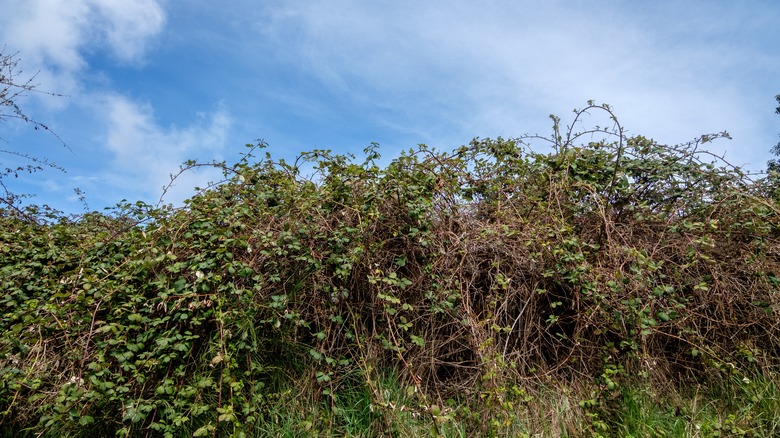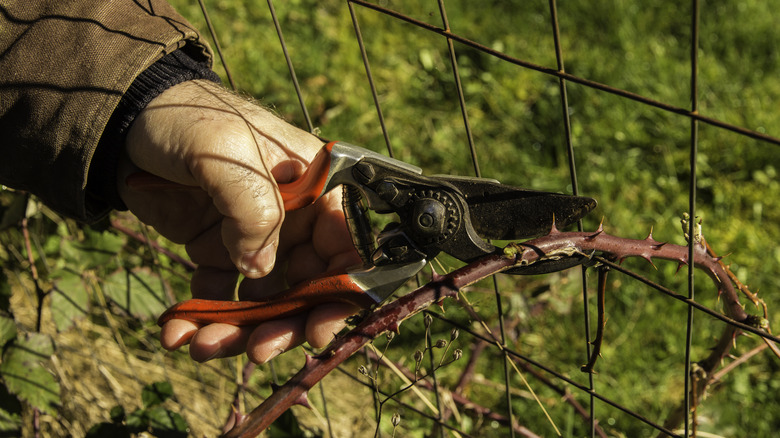American gardeners, farmers, and park rangers — particularly those in the Pacific Northwest and California— battle a green-hued, thorny monster on the regular, armed with hoes, rakes, and sprayers. While this terrible threat to the biodiversity of your backyard doesn’t fight back in the expected fashion, it takes over beds and banks surprisingly quickly. It can even clone itself, making eradication almost impossible. The culprit — the Himalayan blackberry, a fast-growing, tall (up to 15 feet high), semi-woody shrub that is as renowned for its delicious berries as it is infamous for its invasiveness. Your innocent attempt to grow and care for a blackberry plant invites potential disaster for less hardy native flora and fauna and even soil integrity.
The Himalayan blackberry is native to Armenia and probably northern Iran and was introduced to America as a food plant by controversial botanist Luther Burbank in 1885. It’s a mostly evergreen perennial that boasts large, juicy, edible fruit and sweet white to pink flowers, making it a seemingly attractive option for gardeners — don’t be fooled. This thorny fruiting shrub goes by two scientific names in the U.S.: Rubus Armeniacus and, less frequently, Rubus bifrons. It boasts a Class C pest rating in California; Oregon classifies it as a Class B noxious weed, restricting its import via quarantine, while both species are considered noxious weeds in Washington State.
Bad outweighs good

Though oft-mentioned on lists of berry-producing bushes perfect for your yard, the Himalayan blackberry negatively impacts local ecosystems. It quickly cultivates disturbed soil in lowland areas through an extensive, deep rhizomatic root system and efficient seed dispersal via birds and small mammals. If the ends of the canes bend to the ground or the nodes touch the soil, they grow roots, creating clones of the original plant. The problems the plants create are multi-fold: The dense, prickly thickets crowd and shade out other plants, reducing diversity; they often grow along water sources, restricting access for wildlife; their shallow root systems aid soil erosion; and the numerous dry, dead canes create a fire hazard. In Oregon alone, they cover over 1.6 million acres of land.
Anything you plant around a blackberry shrub will quickly get crowded and shaded out by the sprawling canes overground and, underground, by the plant’s rapidly replicating rhizomatic root system. Himalayan blackberries grow ten feet up and twenty feet across in just a year. A blackberry shrub won’t stabilize that steep, crumbly slope in your backyard, either. Its roots reach just 12 inches into the ground. By comparison, the roots of well-known erosion helpers like native grasses extend down many feet rather than inches — for example, six feet in the case of switchgrass. If you’re growing the blackberry for its (admittedly delicious) fruit, you’ll have to battle intimidating thorn-covered stems to reach it. Thornless berry varieties are a much better choice for hungry gardeners.
Hack, dig, spray

There are a few tried-and-true methods for removing a stand of blackberry: cutting the canes, digging out the roots, or applying pesticides. Often, you’ll need to use all these methods at different times of the year or even simultaneously and across multiple seasons to eradicate a thicket. Before you battle this thorny, snake-limbed foe, you need some armor. Don long gardening gloves and socks, full-length pants, long-sleeved shirts, and heavy boots.
Start in the summer by mowing frequently or cutting the canes back to soil level. Then, dig out the root ball. Don’t compost the resulting organic matter, or you risk spreading the plant to other areas of your garden. Seeds in the soil continue to sprout for years. Spray any new canes that pop up with pesticides — the best options being post-emergence herbicides with triclopyr and glyphosate (the former for broad application and the latter for spot treatment only). If you live in an area that freezes, wait until the snow arrives. It’s easy to spot blackberry plants because they’re one of the only plants still with leaves. If you have farmer friends, ask them to lend you a goat or four. Goats, pigs, and chickens readily feast on the plants, as do sheep, cows, and horses. You could also try amending its growing conditions; Himalayan blackberry does poorly in arid soil, full shade, and extreme cold. Of course, if you have these conditions, you probably don’t have a blackberry problem.



